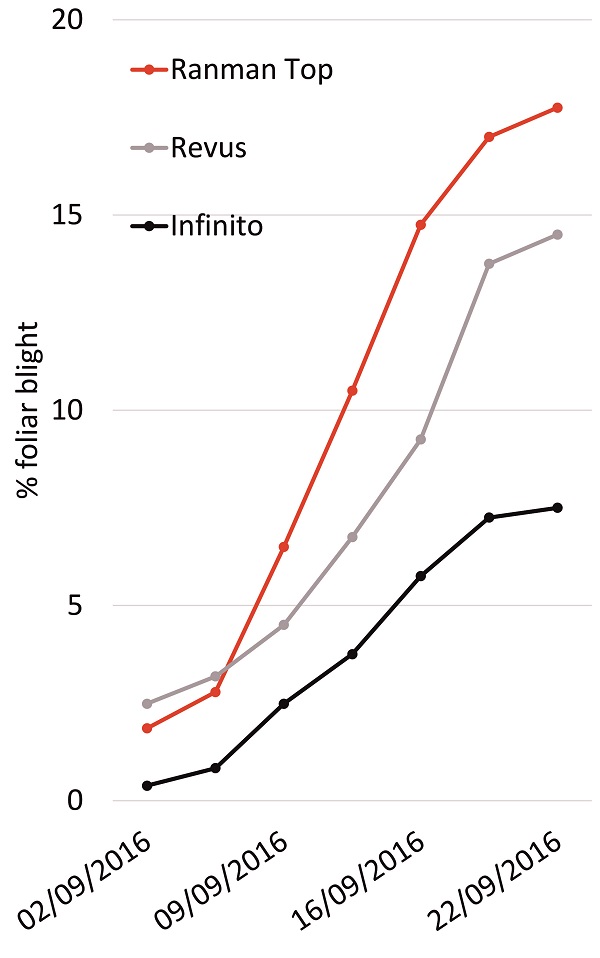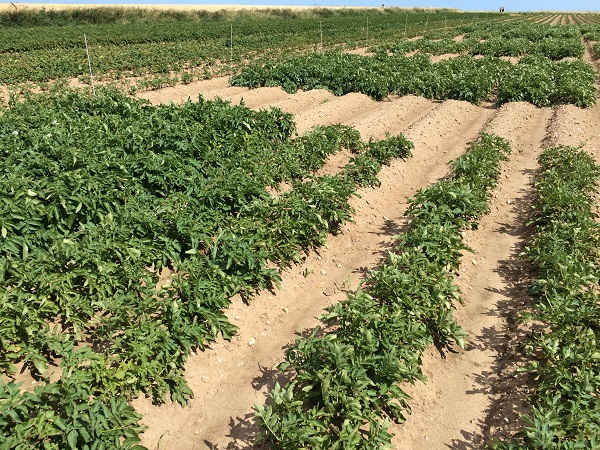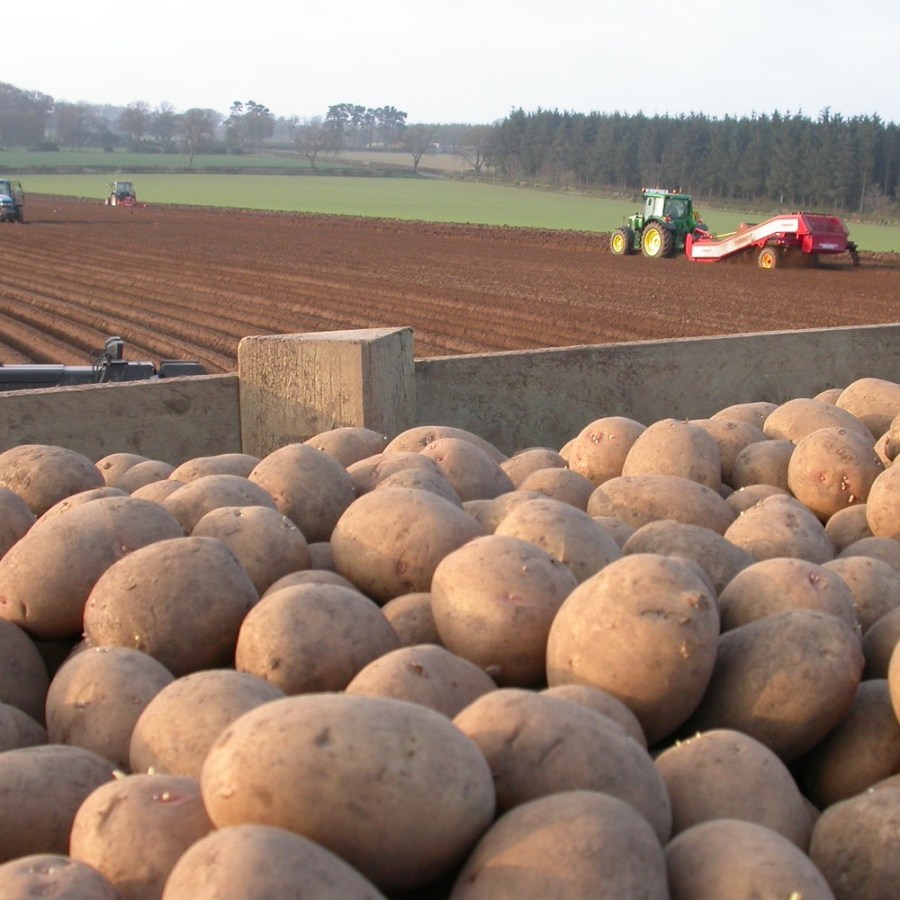Options for nematode control in potatoes have become few and far between, but a new product is now getting close to the market end of the innovation pipeline. CPM finds out more about it.
Part of a wider solution to PCN control.
By Lucy de la Pasture and Rob Jones
The regulatory net has been closing in on the nematicide group of products, with a nematicide stewardship scheme now in place to help secure their future. Fortunately, new products are coming through the pipeline, with an approval in potatoes obtained last season for a new nematicide, Nemguard (garlic extract).
Marketing company Certis are determined to build grower confidence before Nemguard becomes widely available so, for the second season running, the product is set for limited commercial use in trials as a more extensive data set is built up on different soil types and under different conditions.
Independent potato agronomist, John Sarup had a look-see last season, with some Nemguard treated rows alongside Vydate (oxamyl) treated, and he found little difference between them where feeding damage was concerned.
“My feeling is that I’d currently opt for Vydate where I’m trying to control spraing for the simple reason ‘it’s better the devil you know,” he says, underlining the importance of grower confidence which is the reason Certis is taking its time in delivering Nemguard to market.

Source: Bayer
While Nemguard waits in the wings for a proper launch to growers, registration trials performed in support of a new SDHI-based nematicide suggest it provides a useful level of control against both PCN and FLN. In particular, the coded product from Bayer offers a new means of control for growers unable to use the granular nematicide products, such as growers of salad potatoes or those lifting early.
Bearing the development name AR83685, the new nematicide contains 250g of fluopyram when applied at the full rate of 625 ml/ha and is formulated as a liquid spray. It can be applied either as a standard spray, using conventional application equipment followed by incorporation up to three days before planting, or in-furrow at the time of planting with a standard in-furrow sprayer.
Presenting the latest trials results at the Bayer Potato Conference, Nigel Adam, Bayer development manager, explains that AR83685 should not be considered a silver bullet, but part of an integrated strategy.
“This is a new mode of action and one that offers a favourable environmental profile, but it’s only part of a wider solution to PCN control that involves greater use of resistant varieties, improved cultural practices and the continued use of existing nematicides,” he says.
Trials found AR83685 gives PCN control approaching that of full-rate Vydate and Nemathorin (fosthiazate), though performance varied between sites depending on the application method. On average, the biggest increase in marketable yield came when applied to the soil surface (overall), rather than in-furrow.
Across seven trials using several Globodera pallida-susceptible varieties and spanning two seasons, the development product gave an average increase in marketable yield of 5.5t/ha over untreated and a 36% reduction in egg multiplication (using the Pf/Pi measure) when applied prior to being incorporated. In comparison, Vydate (55kg/ha) delivered a marketable yield increase of 9.4t/ha and a reduction in egg multiplication of 41%.
When applied in-furrow, AR83685 produced an average yield increase of 4.1t/ha over untreated and a 27% reduction in egg multiplication.
In 2016 Bayer investigated its contribution to control as part of a programme for PCN control. Although not part of the data required to support its registration, or a recommendation, the trial is perhaps an example of how growers can, in certain situations, make the most of AR83685, suggests Nigel Adam.

NIAB-CUF trial in North Norfolk on cv Lady Claire. The foreground shows untreated compared to AR83685 treated on LHS.
Across five trials using both resistant and non-resistant varieties, both Nemathorin and Vydate were broadcast at half rate and then incorporated before AR83685 was applied at full rate in-furrow at planting.
The addition of AR83685 to half rate Nemathorin gave an average yield increase of 0.8t/ha over the full rate (30kg/ha) Nemathorin control. Similarly, AR83685 plus half rate Vydate gave an increase of 3.2t/ha over the full rate (55kg/ha) Vydate control.
Although not something Bayer was targeting, a trial in Fife in 2015 revealed strong activity against spraing. This effect was investigated further in 2016 with a trial in Yorks, he explains.
In the two trials, AR83685 reduced the numbers of spraing-infected tubers by 93% (overall application then incorporated) and by 71% (applied in-furrow), with resultant increases in marketable yield.
“AR83685 is by no means the complete answer to the problem posed by nematodes, but it will be part of the solution. It’ll be for growers and agronomists to determine how best to use it in their particular situations to contribute to protecting quality and improving the yield of their crops,” says Nigel Adam.
Royal approval for CRFs
Using a controlled released fertilizer (CRF) is paying off for the Jersey Royal Company. In independent trials the technology proved to offer up to 8% higher yields over a conventional nitrogen programme, as well as a wealth of additional benefits, comments Ryan Stone, the firm’s technical manager.
He managed the trials across a 6ha site of the famous Jersey Royal’s and now believes CRF demonstrates a significant opportunity for the Jersey Royal Company – responsible for 65% (1,400ha) of the island’s total potato area, with 20,000t of the early variety exported to the UK mainland annually.
“Last year we applied Agromaster CRF to half of the field trial area. The other half received a standard fertiliser, with both being applied two days before planting,” says Ryan.
The CRF was applied from mid-March until the end of April 2016 at a rate of 180 kgN/ha. “When we monitored the crop, the earlier digs didn’t show much of a difference between the untreated control and the CRF-treated potatoes. But after 12 weeks, the difference was clear and we saw up to 8% yield increase in some fields,” he says.
The benefits of CRF are numerous reckons Ryan Stone, citing the issue of leaching as an example of where these additional benefits really come to the fore.
“From an environmental perspective, Agromaster helps to minimise leaching and this is extremely important for our farming practices. Reducing chemical residues is a very hot topic on our Island,” he adds.
CRFs are being increasingly used to support potato crops, according to Scott Garnett from Agromaster manufacturer, ICL Specialty Fertilizers. “They play an important role in improving yield, reducing nutrient losses and simplifying fertiliser application.
“It limits the need for top dressings because the fertiliser remains available to the plant over a longer period. This means CRF offers vital nutritional support to the crop throughout the whole of the growing cycle,” he comments.
“The way the technology works is simple, but highly effective. The fertiliser granules have an E-max coating which is essentially a semi-permeable layer that controls the release of the fertiliser to the growing plant. This works in conjunction with the soil temperature and moisture content, with more nutrients being made available as the soils warm up.
“If the temperature then drops, the coating condenses and stops the flow of nutrients. When they are fully released, the E-max coating disintegrates harmlessly into the soil,” he adds.
Differences highlighted in Eurofins trial
Late blight fungicide trials conducted in 2016 support the advice to growers to alternate products, while utilising those with recognised curative and anti-sporulant properties during periods of greater pressure, says Bayer root crop product manager, Edward Hagues.
Blight pressure last season began in earnest during June, with the number of confirmed cases rising rapidly due to favourable weather conditions. By early Sept, more than 160 cases had been confirmed across Great Britain.
A Bayer trial at Eurofins compared Infinito (propamocarb+ fluopicolide), Ranman Top (cyazofamid) and Revus (mandipropamid), which together are considered three of the strongest fungicides for late blight control, he says.
To separate the relative performance of these products, plots were treated in blocks, rather than in programmes, at seven-day intervals. Blight was first detected in the untreated plot on 25 July. Within four weeks (21 Aug) more than 70% of the untreated plot was infected and almost three weeks later (9 Sept) this had risen to 100%.
“The rapid escalation in blight pressure during the summer meant there was considerable opportunity to assess the varying performance of the fungicides in the trial before its end in late Sept,” explains Edward Hagues.
“Differences were quickly apparent. By the time the level of foliar blight in the untreated plots reached 70%, we could begin to separate the treated plots. The level of blight in the mandipropamid-treated plots was roughly 50% more than in the Infinito-treated plots, while the cyazofamid-treated plots contained roughly 100% more blight.
“This relationship continued through to the end of the trial, with cyazofamid-treated plots demonstrating nearly 18% foliar blight, mandipropamid-treated plots nearly 15% and Infinito-treated plots nearly 8%,” says Edward Hagues (see chart).




